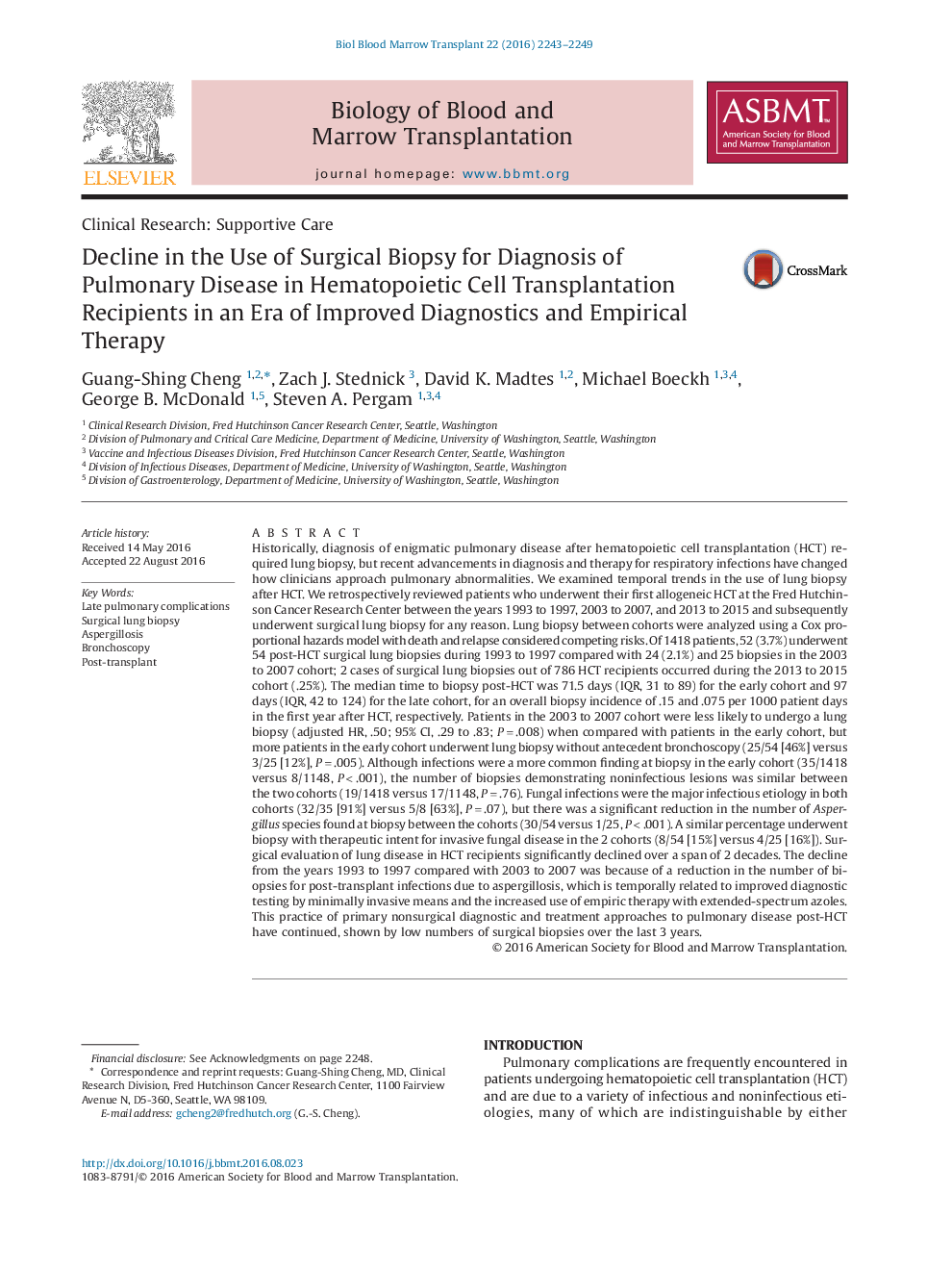| کد مقاله | کد نشریه | سال انتشار | مقاله انگلیسی | نسخه تمام متن |
|---|---|---|---|---|
| 5524320 | 1546247 | 2016 | 7 صفحه PDF | دانلود رایگان |
- Use of biopsy for diagnosis of post-HCT lung disease has declined significantly.
- Improved testing and increased azole use are associated with this decrease.
- Less invasive methods have improved diagnostics for respiratory pathogens.
- We outline an algorithm for appropriate use of lung biopsy in these patients.
Historically, diagnosis of enigmatic pulmonary disease after hematopoietic cell transplantation (HCT) required lung biopsy, but recent advancements in diagnosis and therapy for respiratory infections have changed how clinicians approach pulmonary abnormalities. We examined temporal trends in the use of lung biopsy after HCT. We retrospectively reviewed patients who underwent their first allogeneic HCT at the Fred Hutchinson Cancer Research Center between the years 1993 to 1997, 2003 to 2007, and 2013 to 2015 and subsequently underwent surgical lung biopsy for any reason. Lung biopsy between cohorts were analyzed using a Cox proportional hazards model with death and relapse considered competing risks. Of 1418 patients, 52 (3.7%) underwent 54 post-HCT surgical lung biopsies during 1993 to 1997 compared with 24 (2.1%) and 25 biopsies in the 2003 to 2007 cohort; 2 cases of surgical lung biopsies out of 786 HCT recipients occurred during the 2013 to 2015 cohort (.25%). The median time to biopsy post-HCT was 71.5 days (IQR, 31 to 89) for the early cohort and 97 days (IQR, 42 to 124) for the late cohort, for an overall biopsy incidence of .15 and .075 per 1000 patient days in the first year after HCT, respectively. Patients in the 2003 to 2007 cohort were less likely to undergo a lung biopsy (adjusted HR, .50; 95% CI, .29 to .83; Pâ=â.008) when compared with patients in the early cohort, but more patients in the early cohort underwent lung biopsy without antecedent bronchoscopy (25/54 [46%] versus 3/25 [12%], Pâ=â.005). Although infections were a more common finding at biopsy in the early cohort (35/1418 versus 8/1148, Pâ<â.001), the number of biopsies demonstrating noninfectious lesions was similar between the two cohorts (19/1418 versus 17/1148, Pâ=â.76). Fungal infections were the major infectious etiology in both cohorts (32/35 [91%] versus 5/8 [63%], Pâ=â.07), but there was a significant reduction in the number of Aspergillus species found at biopsy between the cohorts (30/54 versus 1/25, Pâ<â.001). A similar percentage underwent biopsy with therapeutic intent for invasive fungal disease in the 2 cohorts (8/54 [15%] versus 4/25 [16%]). Surgical evaluation of lung disease in HCT recipients significantly declined over a span of 2 decades. The decline from the years 1993 to 1997 compared with 2003 to 2007 was because of a reduction in the number of biopsies for post-transplant infections due to aspergillosis, which is temporally related to improved diagnostic testing by minimally invasive means and the increased use of empiric therapy with extended-spectrum azoles. This practice of primary nonsurgical diagnostic and treatment approaches to pulmonary disease post-HCT have continued, shown by low numbers of surgical biopsies over the last 3 years.
Journal: Biology of Blood and Marrow Transplantation - Volume 22, Issue 12, December 2016, Pages 2243-2249
